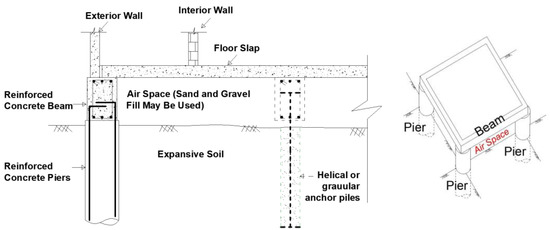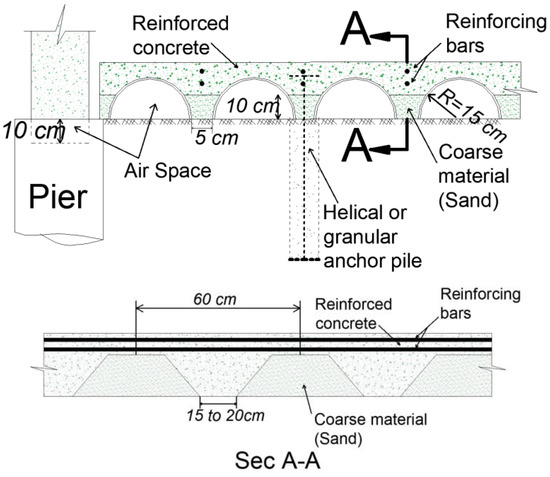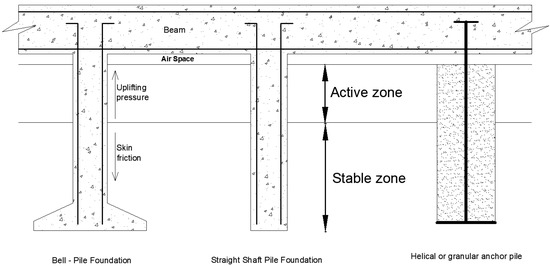You're using an outdated browser. Please upgrade to a modern browser for the best experience.
Please note this is an old version of this entry, which may differ significantly from the current revision.
Subjects:
Engineering, Civil
|
Construction & Building Technology
Expansive soils exist in many countries worldwide, and their characteristics make them exceedingly difficult to engineer. Due to its significant swelling and shrinkage characteristics, expansive soil defies many of the stabilization solutions available to engineers. Differential heave or settlement occurs when expansive soil swells or shrinks, causing severe damage to foundations, buildings, roadways, and retaining structures. In such soils, it is necessary to construct a foundation that avoids the adverse effects of settlement.
- expansive soil
- swelling
- stabilization
- foundations
- uplift force
1. Introduction
Expansive soil is a problematic soil that damages civil engineering structures worldwide [1]. Earthquakes, expansive soils, landslides, hurricanes, tornadoes, and floods are the six most dangerous natural hazards, according to Baer [2], with expansive soils tied for second place with hurricane wind/storm surge in terms of economic losses to buildings. During periods of excessive moisture, expansive soil swells, causing a structure to heave. Expansive soil shrinks when soil moisture decreases, leading to construction settlement [3]. Expansive soil can also create lateral displacement by applying pressure to the vertical face of a foundation, basement, or retaining wall. According to Bowles [4], McOmber and Thompson [5], Nelson et al. [6], and Walsh et al. [7], the soil expands and shrinks in a zone ranging in depth from one meter to more than 20 m below the ground surface. This zone comprises the depth of seasonal variation in moisture; thus, structural damage is due to volumetric changes here, commonly referred to as the “active” or “unstable” zone [8,9]. If volume changes in the active zone of expansive soils occur near a foundation, they cause structural damage. Expansive soil swells excessively when wet and shrinks excessively when dry. Without warning, it may generate large fissures at the surface; the fissures can be 20 cm wide and 4 m deep [10].
As previously stated, swelling soils cause large-scale damage to civil engineering structures due to volumetric increases accompanied by a loss of strength during wet seasons and shrinking during summer [11]. Buildings crack, roads become rutted, and retaining structures deteriorate [12]. These soils are found in almost every country worldwide and challenge geotechnical engineers everywhere [13].
2. Field Identification of Expansive Soil
Soil type identification in the field usually requires determining the index properties of the soil, such as color, texture, and plasticity, without requiring special equipment. Engineers can modify expansive soils’ behavior by mechanical, thermal, chemical, and other means. As a result, it is essential to investigate expansive soil’s physical and engineering properties, primarily when it is used as a construction material or for foundation purposes.
Adem and Vanapalli [58] observed that swelling soils exhibit surface fissures. They may absorb considerable amounts of water through the fissures during rainfall or local site alterations (such as water pipe, sewer, or storm drain leakage). The added moisture creates a soft, heavy, and sticky clay. The clays can shrink and stiffen as they dry, resulting in ground shrinkage (volume reduction) and cracking.
Various classification methods in the laboratory evaluate index properties that infer expansive soil behavior. Typical tests include Atterberg limits and clay size percent to classify a soil’s expansion potential as low, medium, high, or extremely high. Soils classified as CH or CL in the USCS or A-6 or A-7 in the AASHTO classification systems are considered expansive soils in general [59].
Holtz and Kovacs [60] proposed three essential components to identify swelling damage to structures:
-
The soil contains montmorillonite (a highly active mineral with a high swelling potential found in clay).
-
The natural water content of the soil is close to its plastic limit.
-
A source of water is available for potentially swelling soil.
Expansive soils are classified using a variety of systems. In Table 1, Bowels [4] summarized the findings of Holtz [61] and Dakshanamurthy and Raman [62] to classify the swelling potential of expansive soils. Table 1 shows the potential changes in soil volume as a function of the liquid limit (LL) and the plasticity index (PI).
Table 1. Potential changes in the soil volume as a function of liquid limit (LL) and plasticity index (PI) (compiled based on [4]).
| Liquid Limit (LL%) |
Plasticity Index (PI%) |
Potential for Volume Change |
|---|---|---|
| 20–35 | <18 | Low |
| 35–50 | 15–28 | Medium |
| 50–70 | 25–41 | High |
| >70 | >35 | Very high |
AASHTO [63] specifies a method that determines whether the soil is expansive and predicts the magnitude of swelling. The soil’s Atterberg Limits correlate to the natural soil suction during construction, as shown in Table 2.
Table 2. Potential for volume change as a function of liquid limit (LL), plasticity index (PI), and soil suction (compiled based on [63]).
| Liquid Limit (LL%) |
Plasticity Index (PI%) |
Soil Suction (kPa) |
Potential for Volume Change |
|---|---|---|---|
| <50 | <25 | <144 | Low |
| 50–60 | 25–35 | 144–383 | Medium |
| >60 | >35 | >383 | High |
Consequently, a comprehensive foundation design in expansive soils requires a site-specific geotechnical investigation with specialized laboratory testing to identify the index properties (Atterberg limits, moisture content, soil suction), swelling potential, and swelling pressure (e.g., ASTM D4546 [64]). According to Chen [65], the last test is the most important and reliable one for evaluating expansive soils.
3. Types and Suitability of Foundations
There are two types of foundations: shallow foundations (individual [isolated] or combined footing, strip, stiffened mat) and deep foundations (drilled pier, helical piles, granular anchor piles).
According to Jones and Jefferson [66], the principal types of foundations utilized in expansive soils worldwide include pile and beam or pier and beam systems (Figure 1), reinforced rafts, and modified continuous perimeter spread footings, summarized in Table 3.

Figure 1. Pier, helical pile or granular anchor pile and beam foundations (compiled based on [59]).
Table 3. Different types of foundations used in expansive soils (compiled based on [66]).
| Type of Foundation | Philosophy of Design | Advantages | Disadvantages |
|---|---|---|---|
| Pier, helical pile, or Granular anchor pile and beam (Figure 2) | Isolate structure from expansive movement by mitigating swell using anchoring to create stable layers |
Utilized in a wide range of soils; effective in high-swell potential soils | The design and construction processes are relatively complex. Specialized contractors are required. |
| Raft or stiffened raft |
Protects the structure from differential settlements by providing a rigid foundation. | Reliable on soils with a moderate swell potential; no special building equipment is required. | Only works for building relatively simple layouts; comprehensive construction quality control is required. |
| Modified continuous perimeter footing or deep trench fill foundations | Same as raft or stiffened raft foundation—includes stiffened perimeter beams. | No specialized equipment is required for this simple construction. | Ineffective in highly expansive soils or tree-influenced zones. |
In low-swelling soils (PI < 15), standard shallow foundations are frequently used [26] when the footing angular rotation (deflection/span length) ratios (Δ/L) are 1/600 to 1/1000 or the differential movement <1 cm.
Stiffened mat foundations (Figure 2) will support buildings in expansive soil (PI ≥ 15), where the expected differential movement could be as high as 10 cm. The mats’ stiffening beams considerably reduce differential distortion [26]. Table 4 displays the beam spacing and depth according to the type of mat.

Figure 2. Stiffened mat foundations (compiled based on [26]).
Table 4. Beam spacing and depth according to the type of mat (compiled based on [26]).
| Type of Mat | Beam Depth, cm | Beam Spacing, m |
|---|---|---|
| Light | 40 to 50 | 6 to 4.5 |
| Medium | 50 to 65 | 4.5 to 3.6 |
| Heavy | 65 to 75 | 4.5 to 3.6 |
If appropriately designed and erected, a pile or beam-on-a-drilled-shaft foundation will adapt to a wide range of soil conditions and tend to reduce the effects of heaving soil. Deep foundations can support nearly any superstructure with low differential soil movement. They can achieve shaft deflection/spacing ratios of less than 1/600 [26].
4. Fundamental Building Solutions for Expansive Soils
First, this section briefly presents the basic problem-solving methods for expansive soil foundations. Then it addresses using deep foundations to resolve expansive soil problems that are more complex.
Peck et al. [67]; Bowels [4]; Murphy [68]; and Zumrawi et al. [69] suggest three main techniques to prevent structural damage to newly constructed structures caused by expansive soils.
4.1. Reduce or Prevent Swelling
There are three methods to reduce or prevent swelling in soil:
-
Removing and replacing the expansive soil: If the layer of moderately expansive soil is immediately below the foundation, remove it and replace it with improved soil. When correctly compacted, the replacement layer will distribute loads better and reduce the adverse effects of swelling on the foundation (Lytton et al. [70]; Rao et al. [71]; Murthy and Praveen [72]; Walsh et al. [73]; Ahmed [74]; Srinivas [75]). The effectiveness of the removal and replacement method depends on the thickness and soil type of the replacement layer. A thin, impervious cap may prevent surface water infiltration into the underlying expansive clay. In contrast, a granular replacement layer may encourage deeper wetting of the remaining expansive soil.
-
Changing the soil’s characteristics: Gromko [76] provides several ways to reduce, if not eliminate, heave in expansive soils. Economics and workability will dictate the selection of one of the following strategies:
-
Controlling the level of compactness: Gromko [76] concurs that maintaining the degree of compactness is one of the most practical and cost-effective ways to reduce heave in expansive soil. A soil’s swelling potential diminishes when compacted on the high side, possibly 3–4% above the optimum moisture content. However, in cases where the overall heave exceeds 35 mm, a slab on grade will not perform well.
-
Stabilization through chemicals: Chemical stabilization of expansive soil with various stabilizers, such as fly ash, lime, or cement, has dramatically minimized heave; however, contractors use lime stabilization more than any other chemical agent to stabilize expansive soil. Mixing 4% to 8% lime with plastic clay reduces the plasticity index of the topsoil layer while increasing its load-bearing capacity (Gromko [76]; O’Neill and Poormoayed [77]; Bowels [4]; Prusinski and Bhattacharja [78]; Moayed et al. [79]; Belabbaci et al. [80]; AL-TAIE et al. [81]; and Mahedi et al. [82]).
-
Pre-moistening of expansive soil: pre-moistening is another method for increasing the soil moisture content by immersing an area in water. Jeyapalan et al. [83] stated that submerging the expansive soil in water before building attains most of the estimated heave. Slow water seepage through highly plastic soil, on the other hand, may make this time-consuming. A 10–15 cm thick layer of sand, coarse gravel, or granular soil on top of the area will, according to Gromko [76], provide the contractor with an excellent working surface during and after pre-moistening. This layer reduces evaporation, adds a minor surcharge, and creates a level, uniform subgrade.
-
-
Controlling the soil’s water content: One of the most effective ways to minimize the heave of expansive soil is to manage its moisture content. Moisture control technologies applied around the perimeter of structures will reduce wetting or drying under the foundation. Impermeable barriers (such as retaining walls and geotextile membranes), proper drainage systems, and vegetation control will maintain moisture levels [76,77,84]).
4.2. Creating a Flexible Building Style and Designing a Resilient Foundation System
Allowing the soil to swell within cavities built into the foundation’s base (the waffle slab, Figure 3) allows a flexible building style with a robust and stiff foundation system. According to Chen [65], this method has been tested in limited cases in the Denver area with mixed results. Helical or granular anchor piles can be used to support this system.

Figure 3. Design of waffle slab with cavities on expansive soil (compiled based on [65]).
4.3. Isolating the Structure from the Expansive Soil Environment
Short piers or piles lift suspended floor slabs above the active zone of swelling (Figure 4). The harmful movement will not reach the floor slab, keeping the structure intact. Support beams and piers combine to provide an effective foundation system.

Figure 4. Grade beam and piles system (compiled based on [65]).
This entry is adapted from the peer-reviewed paper 10.3390/su15032802
This entry is offline, you can click here to edit this entry!
